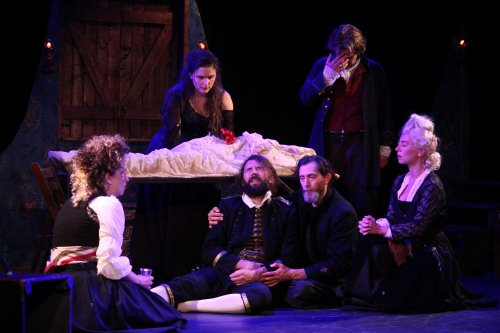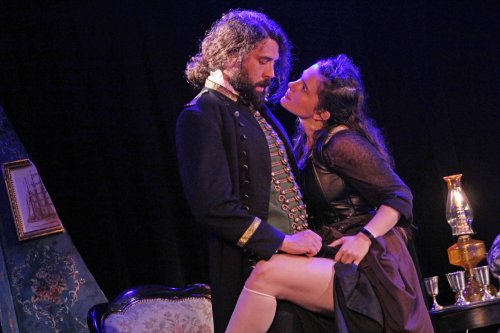The Wake of Dorcas Kelly
Gallows humor abounds in a dramatization of the story of the notorious madam whose execution led to rioting in Dublin, circa 1761.

The Cast of Sara Fellini’s “The Wake of Dorcas Kelly” at the Players Theatre (Photo credit: Giancarlo Osaben)
[avatar user=”Victor Gluck” size=”96″ align=”left”] Victor Gluck, Editor-in-Chief[/avatar]
Using true historical stories in the theater can be a double-edged sword. First you have to make the context and the milieu believable without overwhelming the audience with details. Next you have to create a language and an idiom that conjures up the period. Anachronisms in costuming, music and facts are to be avoided unless the play is intentionally a parody. Chronology must be established as well as the necessary true events of the case. If the characters are well-known, making them look like their usual representations is important. If not, a backstory must be created to clue the audience in to what they should know.
Sara Fellini’s The Wake of Dorcas Kelly is based on the notorious Dublin madam of The Maiden Towers who was executed in January 1761 for the murder of shoemaker John Dowling. In the ensuing riot that took place on Copper Alley, the red-light district of Dublin, 13 prostitutes were arrested and sent to Newgate Prison. Decades later additional stories grew up about Dorcas turning her into Ireland’s first serial killer. The facts vary widely depending on the source and little is known for certain.

Eamon Murphy and Florence Scagliarini in a scene from Sara Fellini’s “The Wake of Dorcas Kelly” at the Players Theatre (Photo credit: Giancarlo Osaben)
Directed by the author, the play, a dark comedy on the stated themes of sex and death, spends its first hour establishing exposition, its cast of characters and a great deal of chit-chat and gossip among Dublin’s 18th century underground. Various people appear to pay their respects to the deceased who had been first hung and then burnt at the stake. The wake is being held by Kate, Dorcas’ right hand manager, and her girls Siobhan, addicted to laudanum, and Myra, embittered and angry. Then a body is found in a trunk and the play speeds up with a great many unforeseeable and rather unbelievable events happening in close succession.
Early in the play, songs are sung by various members of the cast including the anachronistic “The House of the Rising Sun,” (sung twice) set in New Orleans in the twentieth century. The cast members use various accents even though all are supposed to be Irish. Characters come and go for no motivated reason and too many events happen more than once. The acting though vigorous is uneven and inconsistent, but this is mainly due to several underwritten roles which give the performers little to do and not enough backstory. The production’s pacing is deficient as parts of the play come fast and furious while others are slow, talky and languid.

Phoebe Mar Halkowich and Kyra Jackson in a scene from Sara Fellini’s “The Wake of Dorcas Kelly” at the Players Theatre (Photo credit: Giancarlo Osaben)
Pieces of information are often thrown out but are not adequately explained, leaving the audience both distracted and confused. How is there so much of Dorcas’ body for the wake if she had been burnt to a crisp? If William was involved in piracy, how is he now a soldier? Why would Dorcas have murdered Dowling over making Kate pregnant and then abandoning her? How has it been possible to kidnap Father Jack Dancy to give Dorcas the last rites without anyone having noticed his abduction? And why would the whores of Copper Alley have waited three days to express their anger at the death of the famed madam?
Phoebe Mar Halkowich, Irina Kaplan and Florence Scagliarini as the denizens of The Maiden Tower manage to make them very different even though we never learn much about them. Halkowich is particularly authoritative as the new madam, while Kaplan and Scagliarini are impressively feisty. Adam Belvo is rather amusing as the rebel priest recently come from Belfast. Most of the other actors in one-dimensional roles do the best they can to breathe life into their characters.

Irina Kaplan and Florence Scagliarini in a scene from Sara Fellini’s “The Wake of Dorcas Kelly” at the Players Theatre (Photo credit: Giancarlo Osaben)
The physical production is problematic. Best are the period costumes by Claire Daly which might be a tad too clean and tidy for the milieu and the time. The setting by Scagliarini initially suggests three locales but turns out to all be one room. The lighting by Chelsie McPhilimy seems not to vary which does not help with the set’s lack of atmosphere. Playwright Fellini might have let someone else direct so that two heads could have solved the play’s problems rather than attempting both jobs herself. An ambitious historical dramatization, The Wake of Dorcas Kelly is unsatisfying on various levels.
The Wake of Dorcas Kelly (through July 25, 2021)
spit&vigor (theater company)
The Players Theatre, 115 MacDougal Street, in Manhattan
For tickets, visit: www. ci.ovationtix.com/277/production/1045785
More information, visit http://www.spitnvigor.com/the-wake-of-dorcas-kelly
Running time: one hour and 40 minutes without an intermission






Leave a comment